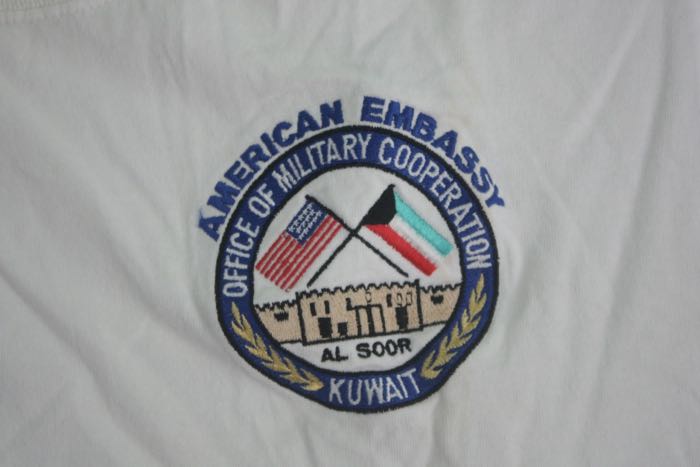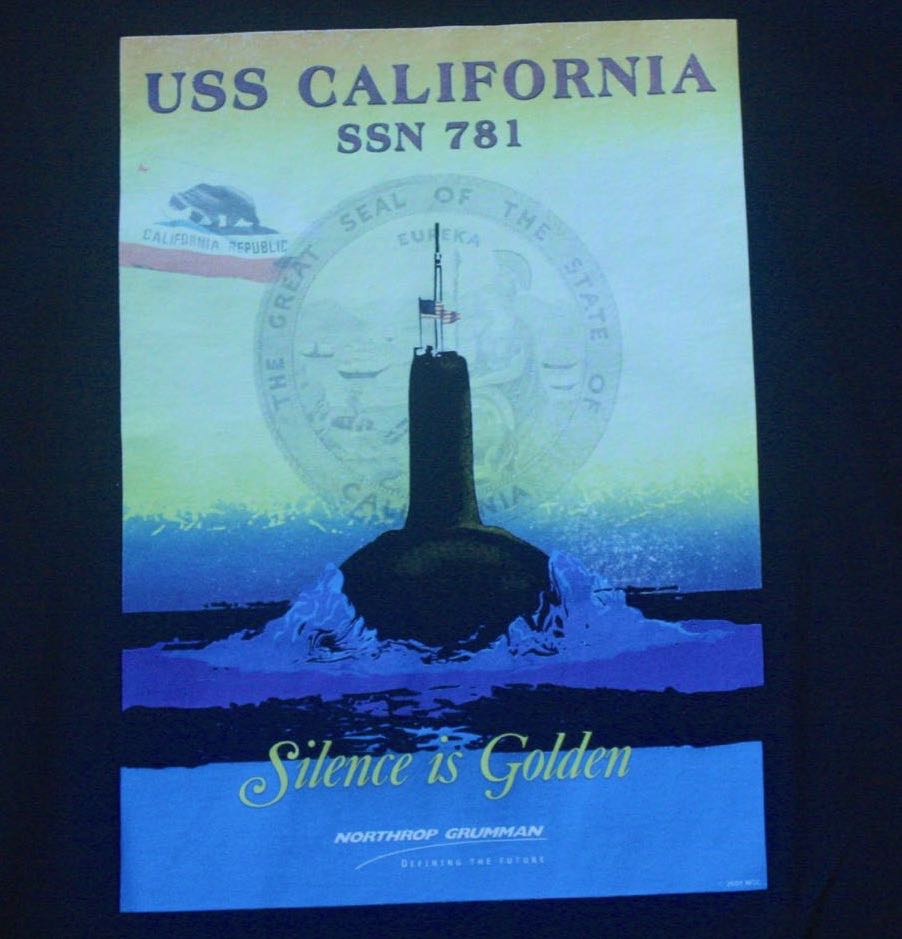I find the damnedest t-shirts at the Capitola (California) Goodwill. Capitola’s one of those deceptively casual beach towns full of millionaires and corporate brahmins and consultants with nice hair, expensive sandals and designer shorts. Some live there, others keep a second home there for weekends away from Silicon Valley or other power nexus around the San Francisco Bay.
They make money by interesting means, and from their travels bring home t-shirts that are also interesting in a sort of New World Order sort of way: VIP t-shirts for an Arianne satellite launch in French Guiana; a tourist tee from Pyongyang, North Korea (it was gray and green); embroidered t-shirts from the U.S. Embassy in Kuwait; plush tees from favored military or national security contractors.

And these are just the tees that end up at the Goodwill. God know what else is hiding in those privileged closets. But I found this one.

Somebody was on the team that rolled out a $2 billion nuclear-powered attack submarine: the USS California, SSN 781. This shirt honors the commissioning of that vessel in 2011.
The California is one of the Navy’s Virginia Class submarines and yet another guaranteed cost-plus-profitable project for defense contractor Northrop Grumman. SSN 781 is a veritable Stradivarius of destruction; although these days the defense establishment prefers the term “force projection.”
Take a good look at the t-shirt and all the California iconography. There’s the Great Seal of the State of California hanging over the sea like a sun; there’s the Bear Flag. Even the name “USS California” is printed in a 19th- or early-20th century font that I used to see in old school books. The ship’s motto, “Silence is Golden,” refers to both the Golden State, and the ship’s stealthy nature. Northrop Grumman’s PR department tried hard to link a 21st century killing machine to California’s heritage.
And do you know what? There is a link, and a big one. This 21st century attack submarine has 200 years of California heritage, or almost. Back to before California was a state, or before it even belonged to the U.S.
The year was 1822, and a child named Joshua Hendy was born in Cornwall, Southwest England. Cornwall lacked opportunity and a lot of other things; when Hendy was 13, he and his brothers migrated to the US to find work. Hendy was a blacksmith in Houston in ’49 when he heard about the Gold Rush. Yellow fever had taken Hendy’s wife and children; Houston had no hold on him. He hopped a clipper ship for San Francisco.
San Francisco is where Hendy built a company and his fortune, not the gold fields. At first, he made tools for prospectors: shovels, picks, sluices. Soon enough he moved up to equipment for the big mining operations that came along: pumps, ore crushers, ore grinders, ore concentrators, giant water cannons.
In the end, Hendy was an engineering genius, and the Joshua Hendy Iron Works helped make the Comstock Lode mineable. Some of Hendy’s mining and ore-handling machine designs stayed current into the 1970s.
Joshua Hendy passed in the 1890s, but the Joshua Hendy Iron Works chugged on under a nephew: more mining machines, and giant locks for the Panama Canal, and steam engines for cargo ships, and more, and more.
When the 1906 quake flattened its San Francisco headquarters, the Hendy Iron works relocated to Sunnyvale in the South Bay for the offer of free land. It became a (very) early tech company in what would become Silicon Valley.
So after Hendy’s death, the next generation of the Hendy family took good care of the company, but the generation after that… didn’t do nearly as good a job.
Flash forward through the 20s and just past the Great Depression: the Hendy Iron Works was on the ropes. Business was down; the payroll, skeletal. The banks were closing in.
But in 1940, a hard-driving engineer and entrepreneur named Steven Moore bought the Hendy Works and turned it around with the backing of a consortium of western engineering firms called the Six Companies.
Moore was a sort of medieval warlord of industry: 6-foot-8, tireless, creative, a largely self-educated engineer and no stranger to getting his hands dirty. He snagged a contract to produce Joshua Hendy 2500 HP Triple Expansion EC-2 marine steam engines to power the Liberty Ships that hauled military supplies in World War II: first a few, then a hundred, then hundreds more.
Moore ramped the company up to 11,000 employees at blinding speed. The “Iron Men and Women of Hendy” mass-produced steam engines at a speed that no one could believe: one 136-ton, 20-foot-tall engine every 40.8 hours from a plant running 24/7.. The Hendy Works built 750 of them in three and a half years, plus dozens of more advanced steam turbines for faster vessels.
The finished engines went straight up to the East Bay, where the Kaiser shipyards dropped them into Liberty ships. One in four of the 3,000 Liberty ships built had an Hendy engine.
Moore moved on after the war as shipbuilding wound down, and the Six Companies sold Joshua Hendy Iron Works to Westinghouse Corp.
Hendy became part of Westinghouse’s Electrical (later Electronics) division. It made pressure hulls for submarines, power distribution systems and steam turbines for utilities, missile launchers and missile guidance systems, radio telescopes, nuclear power plant equipment, and more.
In the ‘90s, Northrop Grumman bought the Electronics Division from Westinghouse, and part of it became Northrop Grumman Marine Systems. And it was that unit, the descendent of the Hendy Ironworks of old, that builds propulsion units for naval attack submarines and missile launch systems for many or most U.S. warships. Including the USS California.
So in a way, “Hendy” still exists as an actual factory, and a big one, at 401 East Hendy Avenue in Sunnyvale, in the heart of Silicon Valley. Master craftsmen still manufacture complicated machinery on the premises as they did 100 years ago; but different machines, and different craftsmen for a different world.
Well, at least it’s a union shop. And there’s an “Iron Man Museum” in the complex that tells the history of Hendy in California: open to the public by appointment.
In short, this t-shirt tells truth. USS California, SSN 781, that can destroy targets in multiple overwhelming ways, is a California boat from a California lineage: all the way back to the Gold Rush.
No quick-minded Cornish blacksmiths lurk on the premises at 401 East Hendy these days, nor towering Thane lords of iron and steam power. Marine Systems is but a small part of the entity that is Northrop Grumman, one of the very few giant defense contractors who dominate and influence U.S. defense spending and policy.
Is there a moral here? I’ll let you find one. But one man, boarding a ship to San Francisco 170 years ago, set in motion a chain of events that continues to this day. Including a t-shirt. To me, finding a tee with a story like this behind it is like finding gold. California gold.
And, just for the hell of it: a video reminder of the Hendy that was, back in its finest hour.
